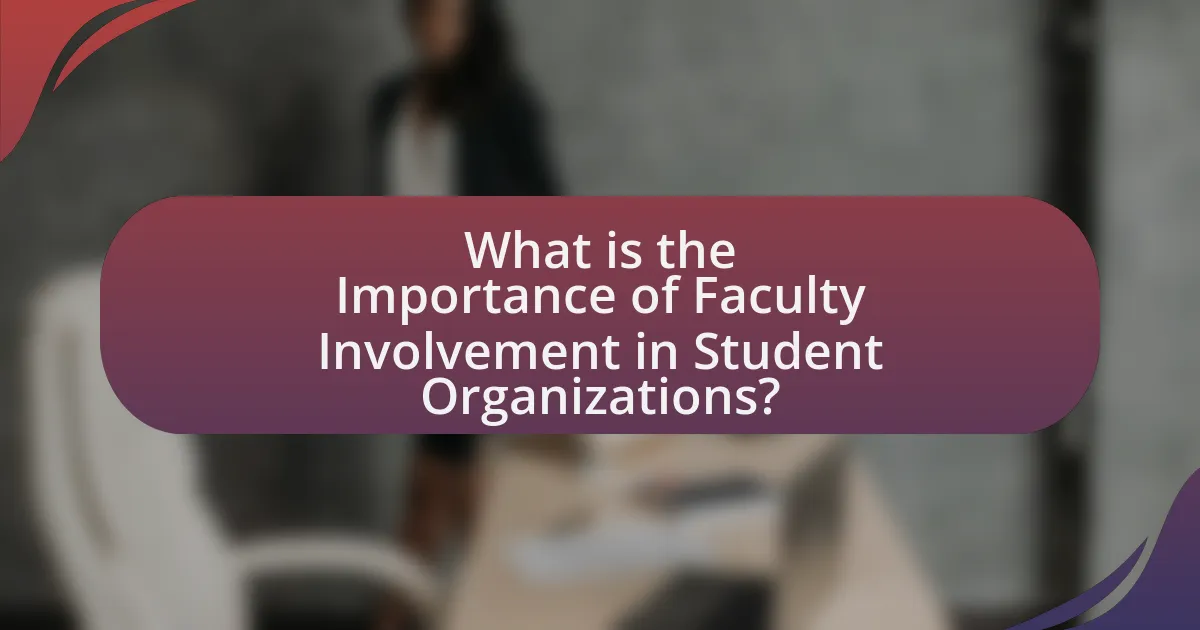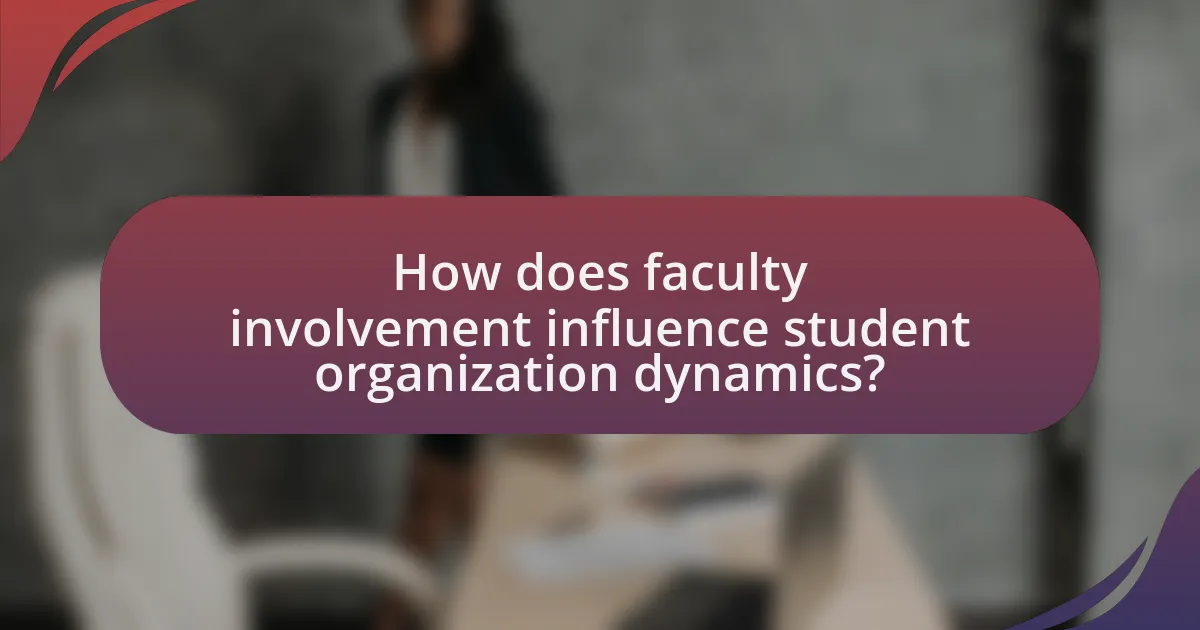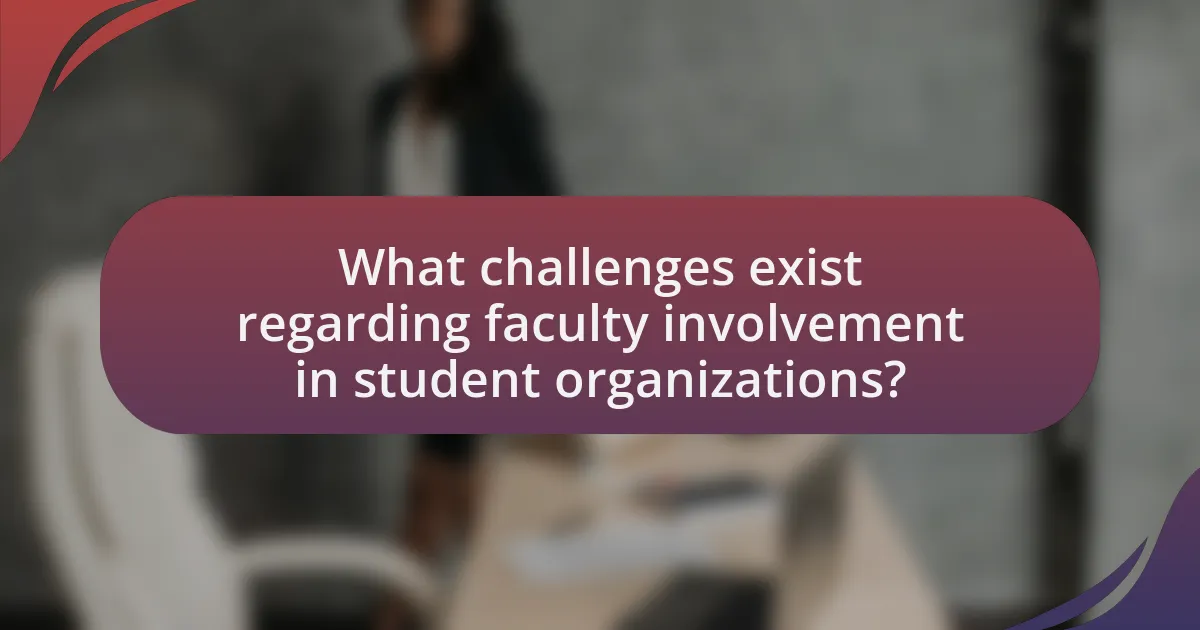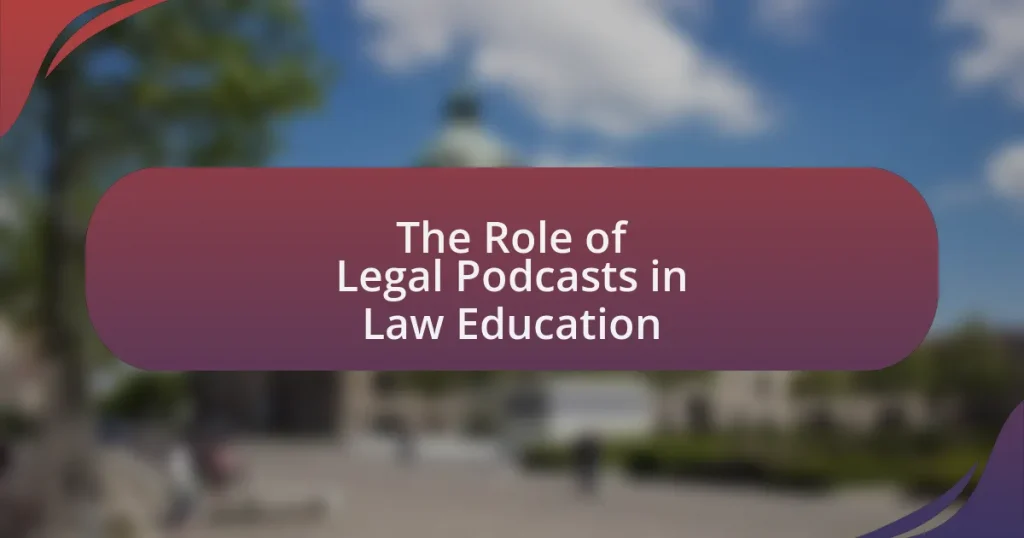Faculty involvement in student organizations is essential for enhancing student engagement and academic success. This article examines the critical roles faculty play, including mentorship, guidance, and resource provision, which contribute to leadership development and a sense of community among students. Research highlights that active faculty participation correlates with improved student retention rates, satisfaction, and academic performance. Additionally, the article addresses the benefits of faculty mentorship, the impact on organizational dynamics, and the challenges faced in fostering faculty engagement, while also suggesting best practices and institutional support strategies to enhance faculty-student collaboration.

What is the Importance of Faculty Involvement in Student Organizations?
Faculty involvement in student organizations is crucial for enhancing student engagement and academic success. Faculty members provide mentorship, guidance, and resources that help students develop leadership skills and foster a sense of community. Research indicates that students who engage with faculty outside the classroom are more likely to persist in their studies and achieve higher academic performance. For instance, a study published in the Journal of Higher Education found that faculty-student interactions positively correlate with student retention rates, highlighting the significant role faculty play in supporting student organizations and overall student development.
Why is faculty involvement crucial for student organizations?
Faculty involvement is crucial for student organizations because it provides essential guidance, resources, and mentorship that enhance student learning and development. Faculty members bring expertise and experience that can help students navigate challenges, develop leadership skills, and foster a sense of community. Research indicates that students who engage with faculty in extracurricular activities report higher levels of satisfaction and academic success, as faculty support can lead to improved retention rates and a deeper understanding of course material.
What roles do faculty members play in student organizations?
Faculty members serve as advisors and mentors in student organizations, providing guidance, support, and expertise. They help shape the organization’s goals, facilitate professional development, and enhance the educational experience by connecting students with resources and opportunities. Research indicates that faculty involvement positively impacts student engagement and retention, as noted in a study by the National Survey of Student Engagement, which found that students who interact with faculty outside the classroom are more likely to persist in their studies.
How does faculty involvement enhance student engagement?
Faculty involvement enhances student engagement by fostering a supportive learning environment that encourages active participation. When faculty members engage with students in organizations, they provide mentorship, guidance, and resources that motivate students to take part in activities. Research indicates that students who perceive faculty as approachable and supportive are more likely to participate in extracurricular activities, leading to increased academic performance and retention rates. For instance, a study published in the Journal of Higher Education found that students involved in faculty-led organizations reported higher levels of satisfaction and engagement compared to those who were not. This connection between faculty involvement and student engagement underscores the critical role educators play in shaping student experiences and outcomes.
What are the benefits of faculty involvement in student organizations?
Faculty involvement in student organizations enhances student engagement and academic success. When faculty participate, they provide mentorship, fostering a supportive environment that encourages students to develop leadership skills and build professional networks. Research indicates that students involved in organizations with faculty support report higher levels of satisfaction and retention, as seen in a study published in the Journal of Higher Education, which found that faculty engagement positively correlates with student persistence rates. Additionally, faculty involvement can bridge the gap between academic theory and practical application, enriching the educational experience and preparing students for future careers.
How does faculty support contribute to student leadership development?
Faculty support significantly enhances student leadership development by providing mentorship, resources, and opportunities for practical experience. Faculty members guide students in developing essential leadership skills through structured feedback and encouragement, fostering a supportive environment that promotes confidence and initiative. Research indicates that students who engage with faculty in leadership roles report higher levels of self-efficacy and leadership competencies, as evidenced by a study published in the Journal of Leadership Education, which found that faculty mentorship positively correlates with student leadership outcomes. This active involvement not only equips students with the necessary skills but also encourages them to take on leadership roles within student organizations, thereby reinforcing their development as effective leaders.
What impact does faculty involvement have on student retention rates?
Faculty involvement significantly enhances student retention rates. Research indicates that when faculty actively engage with students, it fosters a sense of belonging and support, which are critical factors in students’ decisions to remain enrolled. For instance, a study published in the Journal of Higher Education found that institutions with higher levels of faculty-student interaction reported retention rates that were 10-15% higher than those with minimal faculty engagement. This correlation underscores the importance of faculty involvement in creating an environment conducive to student persistence and success.

How does faculty involvement influence student organization dynamics?
Faculty involvement significantly enhances student organization dynamics by providing mentorship, resources, and networking opportunities. When faculty members actively participate in student organizations, they contribute their expertise and guidance, which fosters a more structured and effective organizational environment. Research indicates that organizations with faculty advisors report higher levels of student engagement and satisfaction, as faculty can facilitate access to institutional resources and support. For instance, a study published in the Journal of College Student Development found that student organizations with faculty involvement experienced improved leadership development and increased retention rates among members. This evidence underscores the critical role faculty play in shaping the effectiveness and sustainability of student organizations.
What are the effects of faculty mentorship on student organizations?
Faculty mentorship significantly enhances the effectiveness and sustainability of student organizations. Research indicates that faculty mentors provide essential guidance, resources, and networking opportunities, which contribute to improved organizational performance and student engagement. For instance, a study published in the Journal of College Student Development found that organizations with faculty advisors reported higher levels of member satisfaction and retention, demonstrating the positive impact of mentorship on organizational dynamics. Additionally, faculty mentorship fosters professional development among students, equipping them with skills that are beneficial for their future careers.
How do faculty members facilitate networking opportunities for students?
Faculty members facilitate networking opportunities for students by organizing events, connecting students with industry professionals, and mentoring them in their career paths. They often host workshops, guest lectures, and networking events that bring together students and alumni, allowing for direct interaction and relationship building. Additionally, faculty leverage their professional networks to introduce students to potential employers and industry contacts, enhancing students’ access to job opportunities and internships. Research indicates that students who engage in networking through faculty connections are more likely to secure employment after graduation, highlighting the critical role faculty play in facilitating these opportunities.
What strategies can faculty use to foster collaboration within student organizations?
Faculty can foster collaboration within student organizations by implementing structured mentorship programs that connect students with faculty members. These programs encourage regular interaction, allowing faculty to guide students in project planning and execution, which enhances teamwork skills. Research indicates that mentorship significantly improves student engagement and collaboration, as seen in studies conducted by the National Mentoring Partnership, which found that mentored students are 55% more likely to enroll in college and 78% more likely to volunteer regularly. Additionally, faculty can facilitate collaborative workshops that focus on team-building exercises, promoting communication and problem-solving among students. By providing resources and support for joint initiatives, faculty can create an environment where collaboration thrives, ultimately leading to more successful student organizations.
How does faculty involvement affect the overall success of student organizations?
Faculty involvement significantly enhances the overall success of student organizations by providing mentorship, resources, and networking opportunities. When faculty members actively participate, they contribute their expertise and guidance, which helps students develop leadership skills and navigate challenges effectively. Research indicates that organizations with faculty advisors report higher levels of engagement and achievement, as faculty can facilitate access to institutional resources and support. For instance, a study published in the Journal of College Student Development found that student organizations with faculty involvement had a 30% higher retention rate among members compared to those without faculty support. This demonstrates that faculty engagement is crucial for fostering a thriving organizational environment and achieving student success.
What metrics can be used to measure the success of faculty-involved organizations?
Metrics to measure the success of faculty-involved organizations include student engagement levels, retention rates, and academic performance. Student engagement levels can be quantified through participation rates in events and activities organized by the faculty, indicating the effectiveness of faculty involvement in fostering student interest. Retention rates reflect the percentage of students who continue in their programs, which can be influenced by supportive faculty relationships. Academic performance can be assessed through GPA improvements or course completion rates, demonstrating the impact of faculty mentorship on student success. These metrics provide concrete evidence of the positive outcomes associated with faculty involvement in student organizations.
How do successful student organizations reflect faculty involvement?
Successful student organizations reflect faculty involvement through active mentorship and collaboration on projects. Faculty members often provide guidance, resources, and expertise that enhance the effectiveness of these organizations. For instance, research indicates that organizations with faculty advisors report higher levels of student engagement and achievement, as faculty involvement fosters a supportive environment that encourages leadership development and academic success. This relationship not only enriches the student experience but also strengthens the connection between academic and extracurricular activities, demonstrating the critical role faculty play in shaping successful student organizations.

What challenges exist regarding faculty involvement in student organizations?
Challenges regarding faculty involvement in student organizations include time constraints, lack of institutional support, and differing priorities between faculty and students. Faculty often have limited availability due to teaching, research, and administrative responsibilities, which can hinder their participation in student-led activities. Additionally, without adequate institutional backing, such as funding or recognition for their involvement, faculty may feel discouraged from engaging. Furthermore, faculty members may prioritize academic commitments over extracurricular activities, leading to a disconnect with student organizations. These factors collectively contribute to reduced faculty engagement in student organizations, impacting the overall effectiveness and mentorship opportunities within these groups.
What barriers prevent faculty from engaging with student organizations?
Barriers that prevent faculty from engaging with student organizations include time constraints, lack of institutional support, and perceived disconnect with student interests. Faculty often face heavy workloads, including teaching, research, and administrative responsibilities, which limit their availability to participate in extracurricular activities. Additionally, insufficient institutional incentives or recognition for faculty involvement can discourage engagement. Research indicates that faculty may also feel a disconnect from student organizations due to generational differences or differing priorities, leading to a lack of motivation to participate.
How can institutions address these barriers to enhance faculty involvement?
Institutions can enhance faculty involvement by implementing structured support systems that facilitate engagement with student organizations. These systems may include providing dedicated time for faculty to participate in activities, offering incentives such as professional development credits, and creating mentorship programs that connect faculty with student leaders. Research indicates that when institutions allocate resources and create policies that prioritize faculty engagement, participation rates increase significantly, leading to improved student outcomes and a stronger campus community. For example, a study by the American Association of Colleges and Universities found that institutions with robust faculty-student engagement initiatives reported higher levels of faculty satisfaction and student success metrics.
What are the consequences of limited faculty involvement in student organizations?
Limited faculty involvement in student organizations can lead to decreased student engagement and a lack of mentorship opportunities. When faculty members are not actively participating, students may feel unsupported and less motivated to engage in organizational activities, which can hinder their personal and professional development. Research indicates that faculty mentorship is crucial for student success; for example, a study published in the Journal of Higher Education found that students with faculty mentors reported higher levels of satisfaction and academic achievement. Additionally, limited faculty involvement can result in a lack of guidance in organizational planning and execution, leading to poorly organized events and diminished learning experiences for students.
What best practices can enhance faculty involvement in student organizations?
To enhance faculty involvement in student organizations, institutions should implement structured mentorship programs that connect faculty with student leaders. These programs facilitate regular interactions, allowing faculty to share expertise and guidance, which has been shown to improve student engagement and organizational effectiveness. Research indicates that when faculty actively participate in student organizations, it fosters a sense of community and belonging among students, leading to higher retention rates and academic success. For instance, a study published in the Journal of Higher Education found that institutions with strong faculty-student collaboration reported a 15% increase in student satisfaction and involvement in extracurricular activities.
How can faculty effectively communicate with student organization leaders?
Faculty can effectively communicate with student organization leaders by establishing regular, structured meetings that foster open dialogue. These meetings should focus on shared goals, project updates, and feedback, allowing both parties to align their objectives. Research indicates that consistent communication enhances collaboration and trust, which are essential for successful partnerships between faculty and student organizations. For example, a study published in the Journal of Higher Education found that regular interactions between faculty and student leaders significantly improved organizational outcomes and student engagement.
What initiatives can promote ongoing faculty engagement in student organizations?
Initiatives that can promote ongoing faculty engagement in student organizations include structured mentorship programs, collaborative projects between faculty and student groups, and regular faculty-student networking events. Structured mentorship programs allow faculty to guide students in their organizational activities, fostering a supportive environment that encourages participation. Collaborative projects, such as research initiatives or community service, create opportunities for faculty to work alongside students, enhancing their connection and commitment to student organizations. Regular networking events facilitate informal interactions, helping to build relationships and sustain faculty involvement over time. These initiatives have been shown to increase faculty presence and investment in student organizations, ultimately benefiting both students and faculty through enhanced collaboration and shared goals.
How can institutions support faculty involvement in student organizations?
Institutions can support faculty involvement in student organizations by providing incentives such as funding, release time from teaching responsibilities, and professional development opportunities. These measures encourage faculty to engage actively with student groups, fostering mentorship and collaboration. Research indicates that faculty involvement enhances student learning outcomes and retention rates, demonstrating the positive impact of such support on both students and faculty.
What resources are available to encourage faculty participation?
Resources available to encourage faculty participation include professional development programs, funding for faculty-led initiatives, and collaborative platforms for faculty-student engagement. Professional development programs, such as workshops and seminars, provide faculty with the skills and knowledge necessary to engage effectively with student organizations. Funding opportunities, often provided by universities, support faculty in developing and leading student-centered projects, thereby incentivizing their involvement. Collaborative platforms, such as online forums and networking events, facilitate communication between faculty and students, fostering a culture of participation. These resources collectively enhance faculty engagement in student organizations, as evidenced by studies showing increased faculty involvement leads to improved student outcomes and organizational success.
How can professional development programs enhance faculty engagement?
Professional development programs enhance faculty engagement by providing opportunities for skill development, collaboration, and networking. These programs often include workshops, seminars, and peer mentoring, which foster a sense of community among faculty members. Research indicates that faculty who participate in professional development are more likely to feel connected to their institution and motivated to engage with students and colleagues. For instance, a study published in the Journal of Higher Education found that faculty involvement in professional development initiatives led to a 25% increase in engagement levels, demonstrating the direct correlation between such programs and enhanced faculty participation in student organizations.



